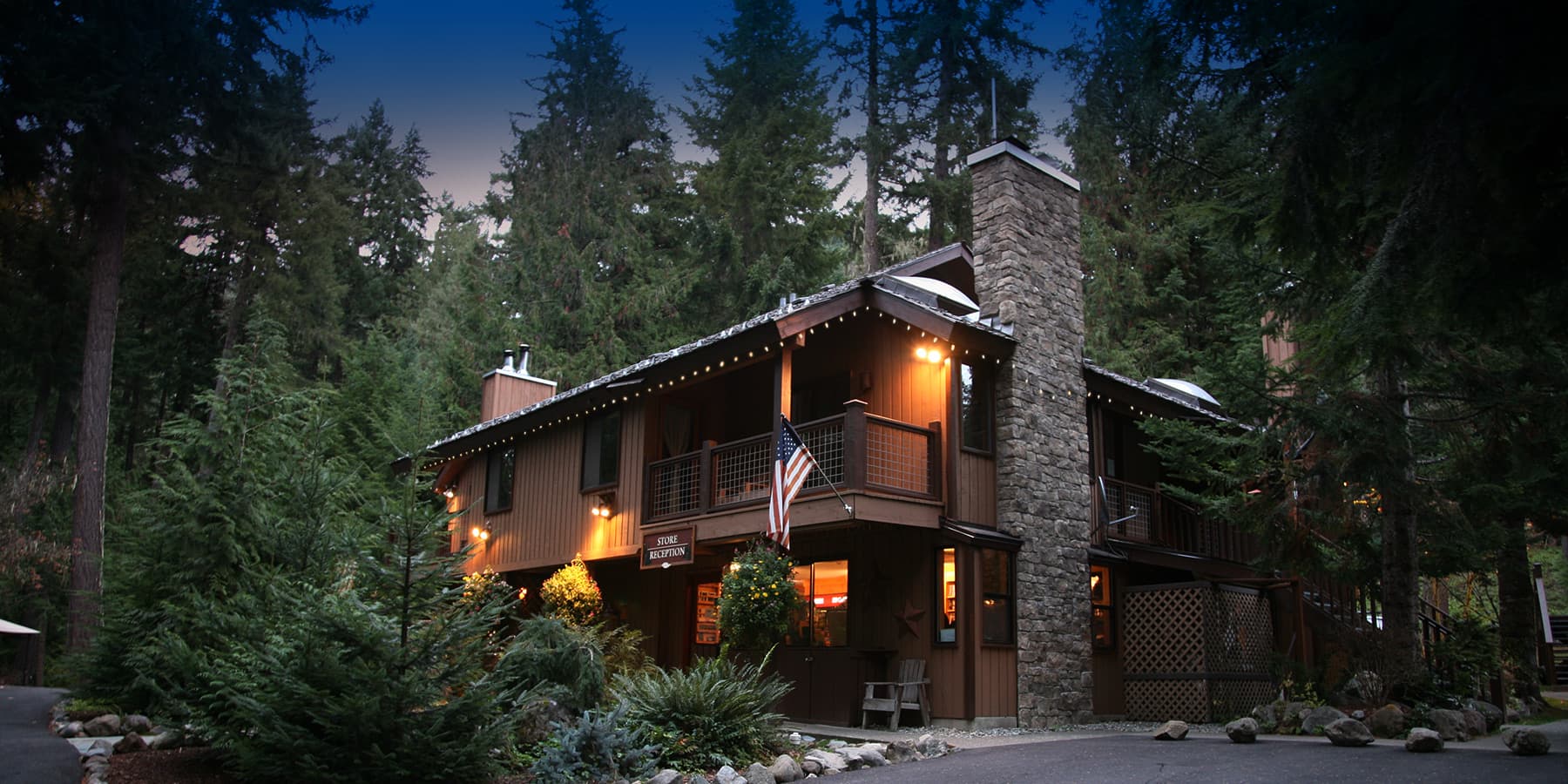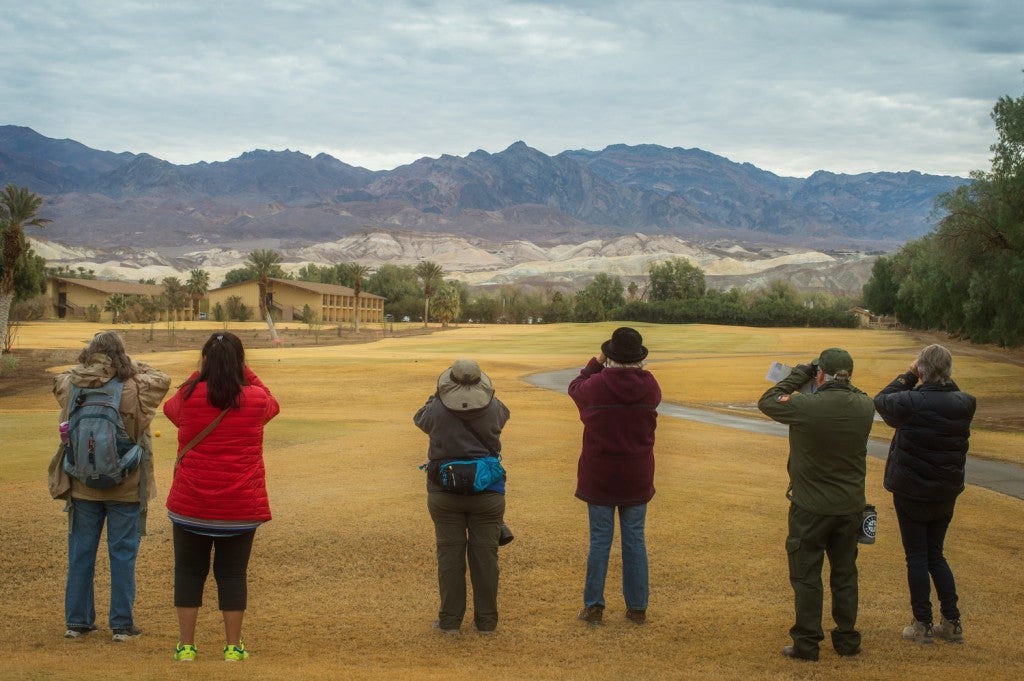This article was brought to you by our friends at Ethnotek. They make everyday backpack and travel bags that seamlessly blend historic textile traditions with modern technology and features—similar to the blend of old and new at National Park Lodges, from the Majestic Yosemite Hotel to the Alta Crystal Resort.
Trains made it possible for Americans to visit the very first National Parks. It was the big railroad companies that funded initial expeditions to what would later become Yosemite, and if they hadn’t brought a young photographer to capture and share the incredible landscapes, your favorite public lands might today be mines, oil fields, and quarries. Once parks were established, it was the trains that most often carried visitors to and from these new destinations.
The railroad companies saw potential in the barely explored West—a place that was drawing a new generation of tourists, eager for a relaxing vacation, but also something a little wild…
9 Stunning National Park Lodges of the American West
Rather than building lodges that looked like the hotels back east, railroad companies hired architects to take inspiration from the landscape, the local building materials, and European mountain architecture. That distinctive new style was attractive to well-to-do travelers who flocked to the National Parks lodges built from the early 1900’s up to World War II. You can still explore a century’s worth of National Park architecture for yourself, from originals like Old Faithful Lodge to modern takes like Alta Crystal Resort.
1. Alta Crystal Resort near Mount Rainier National Park
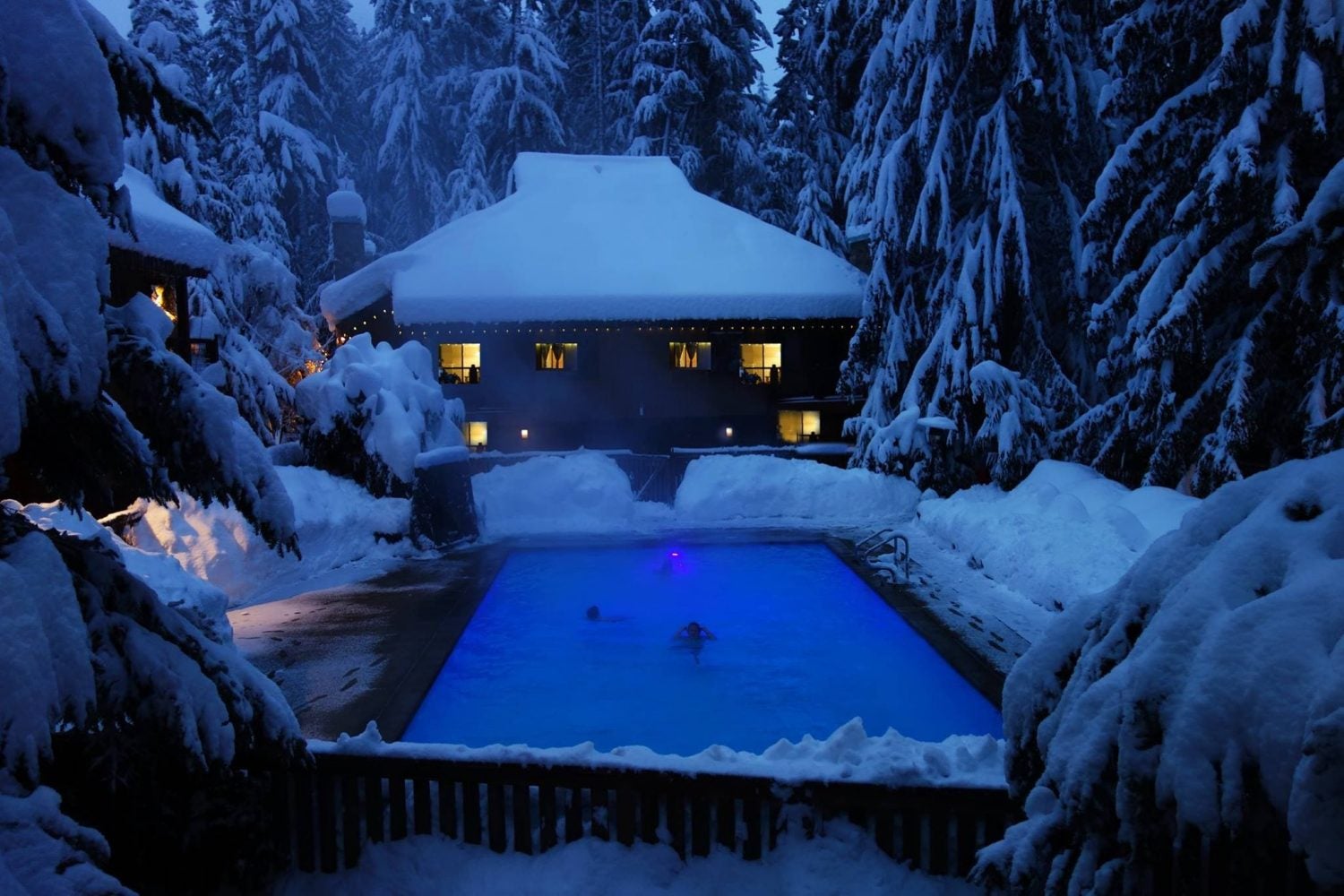
Image from Alta Crystal Resort
The Alta Crystal Resort is a modern example of the parkitecture legacy defined by great lodges like the Old Faithful Inn and El Tovar. The Alta Crystal Resort was built in the 1960s, but features the same sloping roof, wooden siding, and natural stone that define earlier National Park lodges throughout the west.
During the period when most of the other great National Park lodges were built, this area near Mt. Rainier was dominated by the mining industry. It was the construction of the Alta Crystal Resort in the midcentury that revived the region and transformed it into an outdoor and ski destination.
Nowadays, the Alta Crystal Resort sits right outside Mount Rainier National Park and boasts a hot tub, heated pool, and pooch-friendly suites. There are snowshoe and mountain bike rentals, nearby skiing, a scenic gondola ride, and horseback riding in the summer. What it lacks in century-long history it makes up for in modern treats like a 700+ rental movie collection.
2. El Tovar Lodge at Grand Canyon National Park
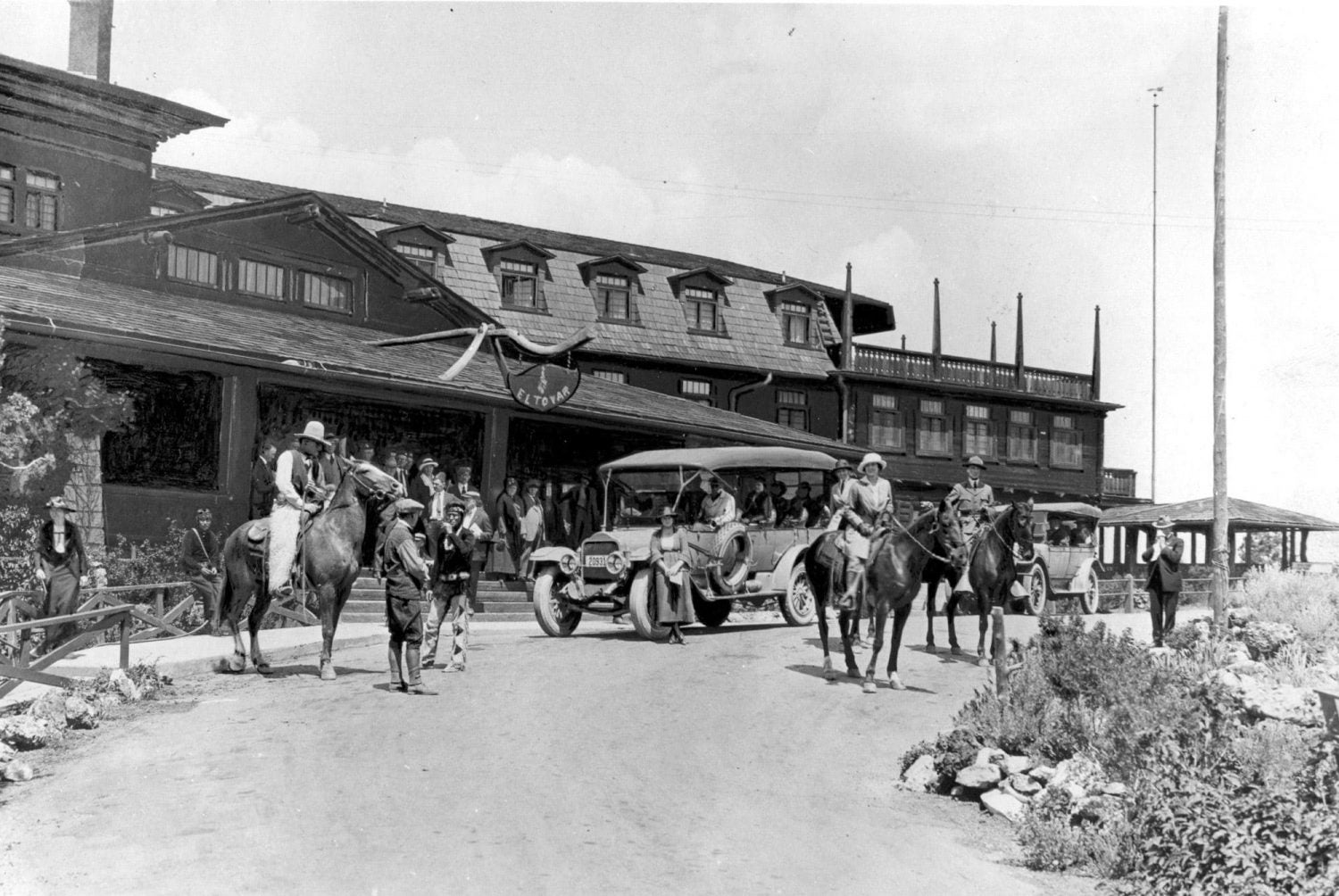
El Tovar Lodge circa 1922 / Image from Grand Canyon National Park Lodges
Just two years after Teddy Roosevelt first visited The Grand Canyon, a magnificent new hotel opened on the natural wonder’s southern rim. El Tovar was named for one of the Spanish explorers who had a hand in discovering the Grand Canyon, and the Santa Fe Railroad commissioned its architect, Charles Whittlesey, for the design. He included then-cutting edge features like a photography studio and darkroom, electric lights, and a rooftop garden. Whittlesey also blended the rustic alpine architecture that had proven effective for similar lodges in Europe with the Mission style that was already synonymous with the southwest.
Today, El Tovar is 113 years old and has hosted thousands upon thousands of vacationing Americans, travelers from around the globe, dignitaries, and celebrities. In addition to Theodore Roosevelt, El Tovar has also hosted William Howard Taft, Gerald Ford, George H.W Bush, Bill Clinton Albert Einstein, and Western author Zane Grey. According to hotel lore, Paul McCartney was once asked to stop tickling the ivories on a lobby piano because it was irritating another guest.
El Tovar was last renovated in 2005, so despite the century of love, you can enjoy all the modern conveniences and comfort. There are 78 rooms, 12 suites, and a dining room so popular it’s wise to make reservations at least a month in advance. You can enjoy special events at the dining room, too, such as their Thanksgiving dinner and Christmas dinner. If you like a little luxury with your nature, El Tovar will feel just right.
3. Timberline Lodge in Mount Hood National Forest

Image from The Timberline Lodge
The Timberline Lodge’s exterior is ultra-iconic thanks to its appearance in Stanley Kubrick’s The Shining. But there’s more to this Oregon hotel than cinematics and the supernatural. Built during the Great Depression starting in 1936, the Timberline Lodge was designed by Gilbert Stanley Underwood. He was the architect who oversaw several other impressive buildings in the National Parks system, including lodges at Zion National Park, Bryce Canyon, and the Ahwahnee Lodge at Yosemite.
Another architect for the Forest Service, William I. Turner, described Underwood’s work on the Timberline as “Cascadian Architecture” for his use of local materials, Native American influences, and a roofline that seemed to mimic the shape of Mt. Hood, on which the Timberline Lodge sits. That Cascadian offshoot of the National Park rustic architecture has continued to influence “parkitecture,” even at more modern projects like the Alta Crystal Resort at Mt. Rainier. Workers camped in big bell tents in nearby Government Camp— which is still used today by many a skier heading up to Mt. Hood’s famous slopes.
These days, you can still enjoy a mug of hot cocoa by the Timberline’s iconic 800,000 pound stone fireplace, hike the Pacific Crest Trail that passes near the property, drink a beer on the upstairs circular balcony, and take advantage of top-notch skiing for one of the longest snow seasons in the country. If you’re a fan of The Shining, we won’t tell if you slip a copy of the Stephen King classic out of your Ethnotek bag for a little reading apres ski.
4. The Ahwahnee and Majestic Yosemite Hotel in Yosemite National Park
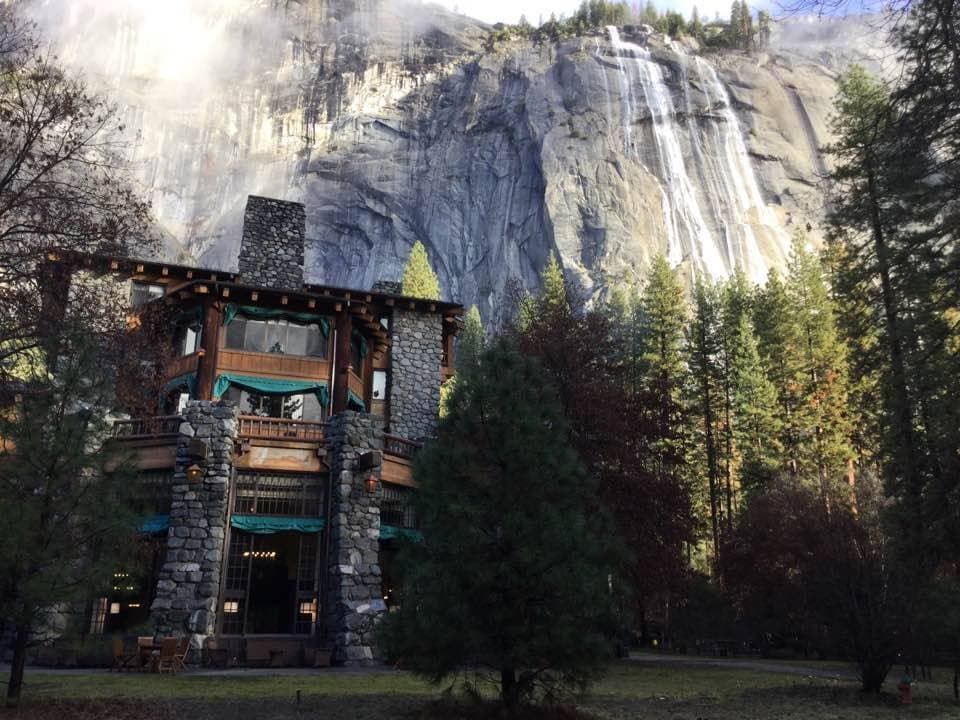
Image from The Majestic Yosemite Hotel
How the Arts and Crafts movement—born in the mid 1800’s in the English countryside—reached the American West is a whole story itself. But we’re glad it arrived, otherwise the Ahwahnee Hotel at Yosemite wouldn’t be the same glittering jewel of the National Parks system we still enjoy today. Ever since it was built in 1927, the goal was to bring as much opulence as possible to Yosemite and attract glamorous visitors who were more accustomed to crystal chandeliers than canvas tents.
In 2011, the Ahwahnee was painstakingly restored with the lodge’s history in mind. The dining room light fixtures were repaired or replaced using the original molds, miraculously still available after 80 years. The carpets and interior decor was refurbished in keeping with the original designers’ vision. That architect was none other than Gilbert Stanley Underwood, who went on to design the Timberline Lodge almost a decade later after his work at Yosemite.
At the Ahwahnee, Underwood got a taste of the unique challenges that come with building national park lodges, from where to source local and regional materials to the early use of cars in supply chain logistics. All that hard work paid off, and today the Ahwahnee is still one of the most magnificent National Park lodges in the West and was declared a National Historic Landmark in 1987.
Despite that long history, in 2016 the Ahwahnee was renamed The Majestic Yosemite Hotel after a dispute with an operations vendor who had copyrighted the original name of the property. Whatever the signage and brochures say, however, this teal-shuttered rose still smells just as sweet. So do the desserts at the famous Bracebridge Christmas Dinner that the Majestic Yosemite Hotel hosts every year.
5. The Chateau at Oregon Caves National Monument

The Chateau circa 1930 / Image from The Chateau at the Oregon Caves
The Chateau at Oregon Caves National Monument stands out for many reasons, not the least of which is an actual stream that flows out of the cavern and straight through the main dining room. The unique design of the building was intended to showcase the area’s unique marble and lumber, all with a signature alpine architectural style with strong French and Nordic influences. Because the opening to the cave itself is so understated, part of the role of the lodge was to create an eye-catching entrance that cemented the place as a real destination.
Unlike some of the bigger, busier lodges in Yosemite and the Grand Canyon that have already been renovated, Oregon Caves National Monument is only just going through its own major restoration. It will be closed for the better part of two years to bring it into compliance with the Americans with Disabilities Act, to install modern fire suppression systems, and other necessary updates. With those structural changes come historically accurate upgrades, too, like putting balconies on the exterior as they were originally intended to be.
If you want to get a sense of the deep level of attention being paid to the Oregon Caves National Monument restoration, just look at what they’re doing about the furniture. Throughout the lodge’s main gathering room is the largest public collection of Monterey Furniture in the country. These antique pieces are made of Oregon alder wood and are synonymous with the lodge’s style.
The Friends of Oregon Caves National Monument are working with a furniture restorer to bring the pieces back to as close to original condition as possible, and in other cases create seamless replicas for the downstairs dining room, where many of the originals were lost or damaged in a 1964 flood. Once the lodge reopens, don’t miss the other big treat downstairs—the classically retro coffee room with low stools and diner-style counters that are perfect for mingling with other guests over pancakes and local Taylor’s Sausage.
Please note The Chateau will be closed for 2019 and 2020 for repairs and renovations.
6. Old Faithful Inn in Yellowstone National Park

Old Faithful geyser erupting near Old Faithful Inn / Image from Yellowstone National Park Lodges
It’s one of the best examples of “parkitecture” on the map and currently reigns as the largest log structure in the world. That’s especially impressive for a building even older than El Tovar, standing in a region known for natural disasters. The Old Faithful Inn survived a 1959 earthquake and the epic Yellowstone fires of 1988, the later of which destroyed several other structures in the worst burn on record within the park. That’s great news for modern visitors—the Inn is the most requested lodging in all of Yellowstone.
The Old Faithful Inn was built in 1903 with lodgepole pine and rhyolite stone, and boasted both electric lights and steam heat. It was dreamed up by one Robert Reamer, a 29-year-old architect for the Northern Pacific Railway. Despite the fact that several other architects’ plans had already been approved, Reamer’s vision was chosen specifically because his rustic concept was both a more natural fit for a National Park and unlike anything else in the country.
Some of the Inn’s best qualities aren’t the enormous beams or grand staircases, but instead the way the building fits into Yellowstone’s already epic landscape. You can see the geyser for which the inn was named from the porch (not to be confused with the epic Steamboat Geyser). The steep gables on the Inn’s roof even echo Yellowstone’s famous rock formations. A hundred and fifteen years later, it’s easy to see why so many of the great National Parks lodges were modeled on Reamer’s magnum opus.
7. Crater Lake Lodge in Crater Lake National Park
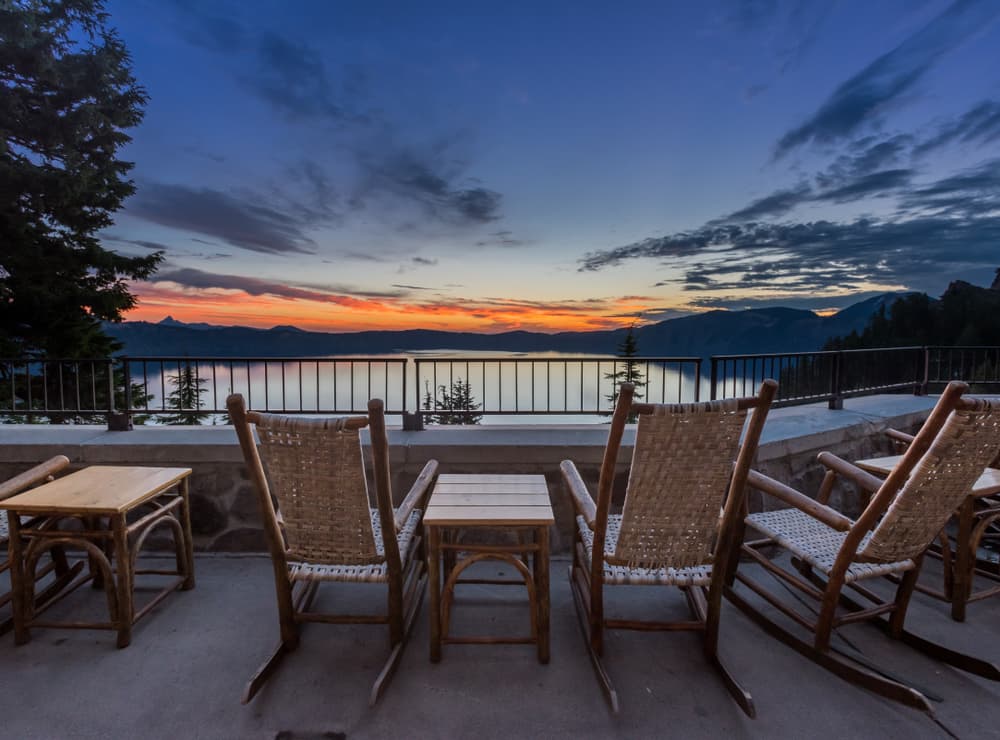
Watch the sunset over the lake from the Crater Lake Lodge
Unsurprisingly, when you’re doing something that’s never been done before, like building grand hotels in rural, wild places in an era of rapidly evolving transit options and limited building codes—there are going to be some mishaps. In the long line of success stories in the creation of the National Parks System, the Crater Lake Lodge was originally one of the duds.
In many ways, it’s a miracle that this iconic lodge has survived to the present day. It’s had several close calls, most of which stem back to the fact that the Crater Lake Lodge was initially as badly built as it was beautiful. It was cramped, drafty, and loud. So how did it stage a comeback that earns it a place on this list?
The Crater Lake Lodge scraped by through decades of calls for its demolition, saved only by its historic character and the necessity for a hotel at one of Oregon’s biggest natural landmarks. In the late 1980’s and early 1990’s, the lodge was literally on the verge of collapse and the National Parks Service came up with a hail-Mary plan to save the exterior appearance of the lodge while reconfiguring the interior for modern standards of safety and comfort.
The result is a modern take on parkitecture that is heavily inspired by more successful examples of the Cascadian style and the Lodge’s original Art Deco era, but which is far more comfortable than the original. These improvements pleased Crater Lake loyalists who were desperate to save the lodge from demolition, and the park’s 756,344 annual visitors.
8. Lake McDonald Lodge in Glacier National Park
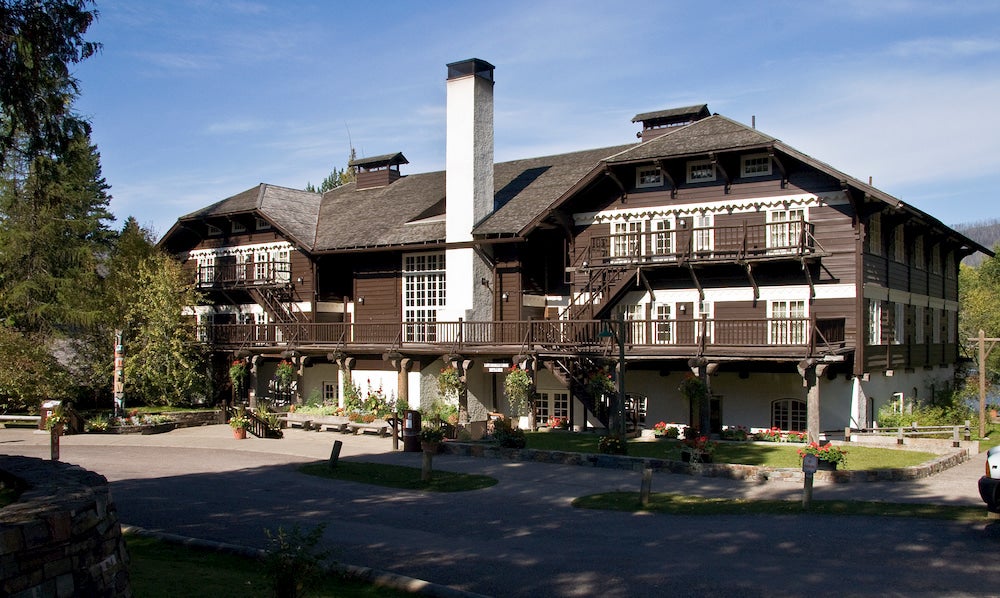
Image from Acroterion on Flickr — CC BY-SA 3.0
This summer, much of the news coming out of Glacier National Park revolved around the Howe Ridge wildfire that threatened the western side of the park. But the Lake McDonald Lodge has survived many such threats to the park in the last century and many other changes along the way. Unlike other National Park lodges that were built by railroad company architects at the outset, Lake McDonald Lodge was originally built to compete with the grand railway hotels.
Once they obtained the land on which the Lodge now sits, John & Olive Lewis found an architect who could mimic the blend of Alpine, Arts and Crafts, and rustic style pioneered by the architects working for the railroads, such as Gilbert Stanley Underwood. Perhaps there was some added foresight to that decision, as the Lewis brothers ultimately sold to the Great Northern Railway in 1930. Prior to that sale, guests could only reach the lodge by boat—which is why it now seems like the more interesting side of the building is at the back.
Today, Glacier National Park visitors no longer need to rely on trains or boats to reach the lodge. The park is auto-friendly and tourists love to drive the Going to the Sun Road that traverses the park. Numerous renovations have ensured the kitchens, safety systems, and creature comforts are up to modern standards. However, the original charm brought by the Lewis brothers remain in the form of century-old hunting trophies, furs, and tchotchkes that give this beloved Lodge its signature ambiance.
9. Paradise Inn in Mount Rainier National Park
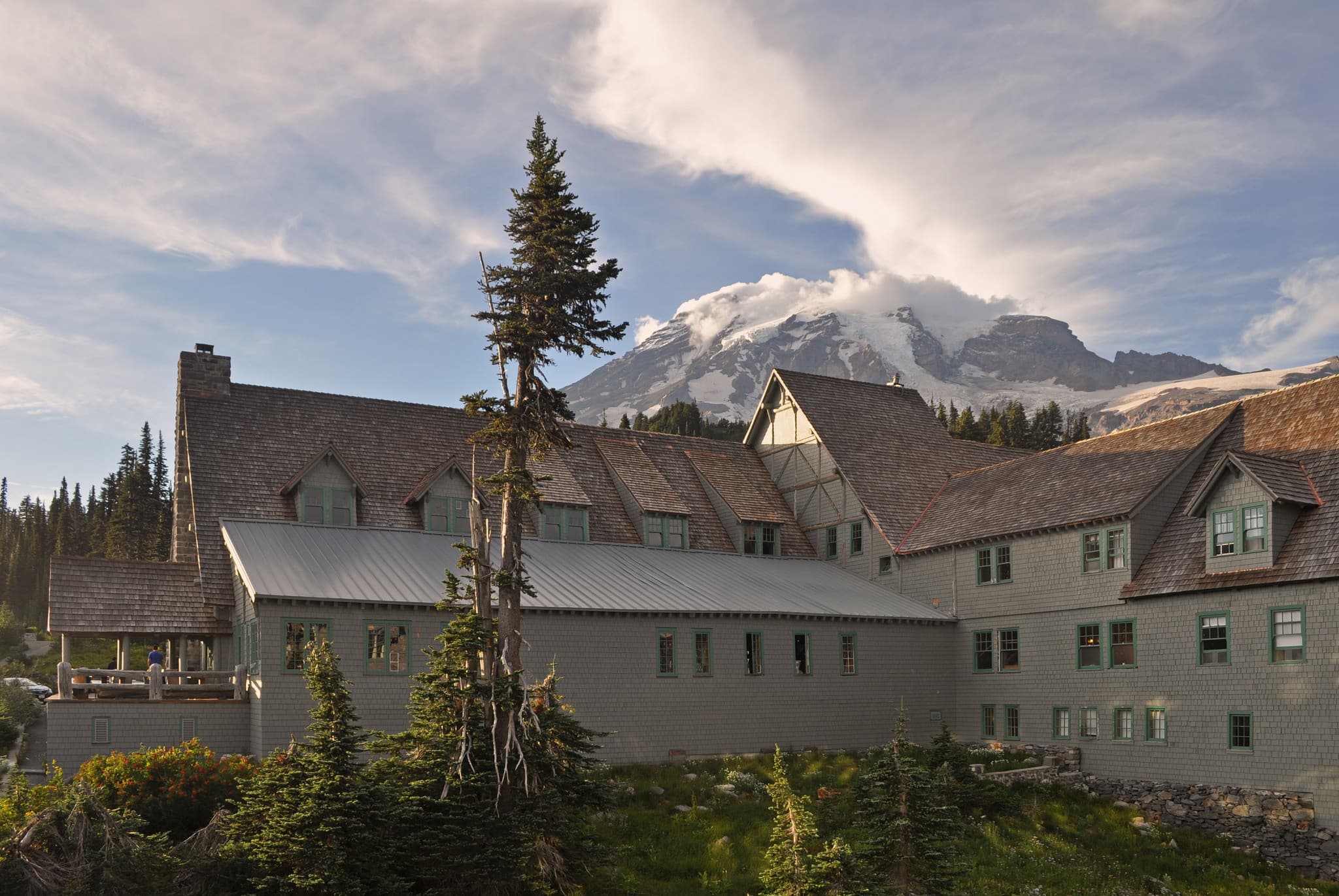
Image © Harshil Shah from Flickr CC BY 2.0
Alta Crystal Resort isn’t the only great lodge in Mount Rainier National Park. On the other side of Washington’s tallest peak is Paradise Inn. If the goal of the National Park Service’s rustic style was, in part, to blend in with the natural environment, then Paradise Inn was a big success.
The Inn has a green and silvery glow thanks to one-of-a-kind Alaskan cedar beams and shingles salvaged from a wildfire, as well as a sloping green roof that perfectly matches the hues of the Pacific Northwest. Even in Washington’s notoriously wet winters, natural light filters through the French doors and dormer windows into the lodge’s great hall. The Japanese paper lanterns are a nod to the region’s rich Asian-American history and the 1920’s yen for all things Eastern.
Like the Crater Lake Lodge, Paradise Inn almost met the wrecking ball in the mid-century. Decades of wear and tear reduced occupancy during the Depression, and a period of closure during World War II took its toll. But despite being a little worse for wear, people loved the Paradise Inn and fought to save it from demolition. It was saved in 1979, declared a National Landmark in 1987, and was beautifully restored in 2006.
A century after it was first designed by Tacoma architect Frederick Heath, the Paradise Inn is now getting another renovation to its guest rooms and will reopen fully in early 2019. There’s a lot to look forward to when the Paradise is open, from local mountain climbing schools to guided snow walks to lush spring wildflowers.
The Dyrt is the only camping app with all of the public and private campgrounds, RV parks, and free camping locations in the United States. Download now for iOS and Android.Popular Articles:
Articles on The Dyrt Magazine may contain links to affiliate websites. The Dyrt receives an affiliate commission for any purchases made by using such links at no additional cost to you the consumer.

